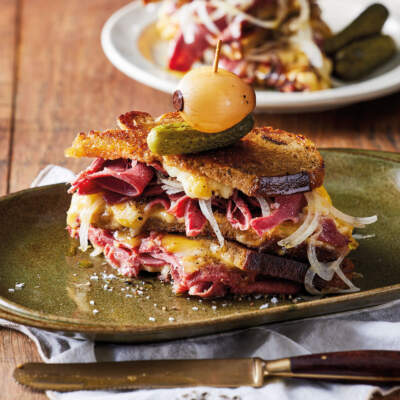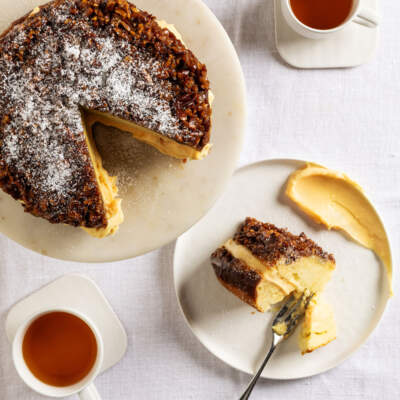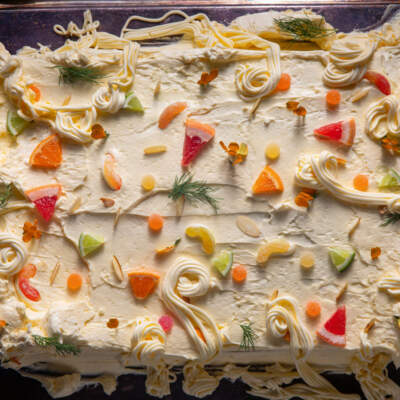How to temper chocolate
You’ve probably heard this term uttered during an episode of MasterChef, but there’s no reason to fear it. The process of tempering chocolate is easier than you think and yields an incredibly satisfying result.
What is tempering chocolate?
Tempering chocolate refers to the controlled heating and cooling of chocolate to give it a shiny appearance and a crisp snap. Tempered chocolate not only looks impressive, it also adds a ‘preserving’ element to the finished product. Tempered chocolate won’t melt as quickly as regular chocolate and acts as a secure shell for whatever soft filling is inside. There are a couple methods of tempering, which are seeding, tabling and a process of heating and cooling the chocolate to a specific temperature (using a thermometer) depending on the type of couverture you’re using.
What do I need to know about tempering chocolate?
There’s no two ways about this, tempering chocolate is a rather fiddly process, one that requires patience and specific tools. In classic French patisseries, you might find an automatic tempering machine, but failing that, you’ll get by with a thermometer, a metal spatula and a non-stick silicone baking sheet or wax paper. Once you’ve got your kit sorted, you’ll also need somewhere to melt the chocolate – either in a microwave or in a double-boiler, which you can make by setting a glass bowl over a bowl of barely simmering water.
What can I do with tempered chocolate?
Tempered chocolate is mostly used to cover filled chocolates and other friandises, but it can also make an impressive garnish for desserts or cakes.
A note on the chocolate
If you’re going to temper chocolate, you could probably make do without any tools but you won’t get very far if you’re not using the correct chocolate. If you’ve ever noticed the word ‘couverture’ on a chocolate bar, this is the chocolate you’ll want to reach for when tempering, as it literally translates to ‘covering’. This chocolate has a higher cocoa butter percentage and generally contains less additives such as vegetable oil, flavourings, milk powder or soy lecithin. For tempering success, look for chocolate with at least 32% cocoa butter as this will give the finished product that desired glossy shine. You can temper all types of chocolate, provided they have a high enough cocoa butter content. Glen Williams, owner of Foxcroft restaurant and bakery in Cape Town stressed this to us: “Spend the extra money on proper couverture, if there are any ingredients other than cocoa mass, cocoa butter, sugar, vanilla and lecithin (and milk solids for milk chocolate), then don’t bother trying to temper.”
Not sure what to do with your tempered chocolate? Here’s some inspiration. Find our step-by-step guide on how to temper chocolate below the recipes.
Chocolate mousse, espresso sabayon and chocolate shards

Get the recipe for chocolate mousse, espresso sabayon and chocolate shards here.
Two-ingredient magic shell

Get the recipe for two-ingredient magic shell here.
Christmas Yule log

Get the recipe for Christmas Yule log here.
Temper chocolate in 6 easy steps
Method
To temper chocolate by tabling: finely chop 300 g couverture chocolate, ensuring they’re evenly-sized.
Place the chocolate in a glass bowl and fit over a saucepan of simmering water (ensure the bowl does not touch the water). Stir continuously until melted.
Remove the bowl from the heat and pour out three-quarters of the molten chocolate onto a clean, cool, smooth surface. A slab of marble is ideal here but a cool countertop will work too.
Use a flexible spatula to thinly spread the chocolate onto the surface, then scoop it up repeatedly, ensuring you keep it moving as it cools to a temperature of 28°C – check this on a thermometer.
Return the chocolate to the bowl and mix in the reserved chocolate – when the temperature of the mixture reaches 32°C, your chocolate is ready to use.
After tempering, you can use however you desire - for bon bons or to fill moulds or to make chocolate shards. To make the shards, spread the molten chocolate evenly onto a sheet of wax paper, then carefully roll into a thick tube. Leave to set before carefully peeling away the wax paper. Alternatively, spread it over the wax paper, allow to set and then break into shards for a garnish.








Comments